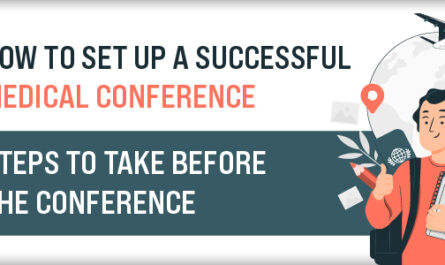Scientific conferences play a crucial role in the interchange of ideas and knowledge within the scientific community. Conferences even offer early career researchers the opportunity to gain exposure in their field of research. Although the COVID-19 pandemic has interrupted traditional in-person conferences for the foreseeable future, the development of virtual conferences has brought to the limelight many of the disadvantages linked with in-person events and demonstrated the benefits of moving these conferences online. Based on data and the real experiences of attendees of in-person and virtual conferences on a range of topics, this blog offers insight into how virtual academic conferences are more inclusive, cheaper, less time-consuming, and more accessible globally, particularly for early-stage researchers. Making international academic conferencing more open and inclusive will offer both immediate and long-term advantages to the scientific community.
Many researchers are unable to attend conferences in person due to financial and logistical barriers. Virtual conferences reduce or remove these barriers by reducing both cost and travel time – they also reduce “bureaucracy” (e.g., the necessity for visas) experienced by some researchers and make it simpler for people with disabilities or vulnerabilities and those with family responsibilities to also be able to take part. Another advantage is that they have a very small carbon footprint. Virtual conferences are also considerably more affordable for scientific societies to organize, allowing for lower registration costs than in-person meetings. This allows for more effective utilization of funding since taking part in-person conferences costs researchers a total of tens of billions of dollars each year. Largely owing to the recent pandemic, the number of online conferences has been increasing dramatically in the past few years, attracting a great number of participants from all over the planet.
Virtual formats have enhanced conferences using a host of audio-visual technologies to facilitate real-time discussions, extended question-and-answer sessions, electronic posters and follow-up discussions, training workshops, informal networking, events brainstorming sessions, and virtual industry exhibits. A number of conferences have integrated virtual reality tools to create new international virtual conference environments, as well as machine learning applications and algorithms to match attendees with similar research interests into virtual chat rooms, allowing networking and collaboration. Some virtual conferences were held for extended periods of time (weeks instead of days), allowing for the participation of researchers from multiple time zones through live and recorded discussions, asynchronous discussions, and social gatherings. Recordings made it possible to pause or rewind discussions, an advantageous feature for those who missed out on certain info or planned to spend more time thinking about a crucial slide. Virtual conferences have further increased structured archiving and open access to abstracts, posters as well as other research materials. Live reviews and analyses of research presentations and other scientific outputs allowed for widespread engagement between speakers and audiences worldwide (reaching as many as one hundred thousand chat messages at a single conference).
Virtual conferences can also help researchers and scientific societies meet more frequently and construct long-term, inclusive, economically endurable, and effortlessly accessible communities regionally and globally within specific domains and across disciplines.
Giving Early Career Researchers Equal Opportunity
In-person lectures exacerbate inequalities in academic communities. Enhancing the diversity of research environments is crucial for scientific innovation and will increasingly be a priority of research and funding institutions.
- Facilitates Multi-Disciplinary PerspectivesUndergraduate trainees, graduate scholars, postdoctoral researchers, and female scholars have less economic agency and travel less than tenured professors and their male colleagues to attend in-person conferences. Since virtual conferences have considerably lower or no registration fees, they are open to a broader range of researchers. Having researchers from a range of backgrounds and life experiences at scientific conferences brings more diverse perspectives and creativity to solving complex scientific problems.
- Breaks Language BarriersAllowing presentations in multiple languages with subtitling and translation will further encourage scientific exchange between nations.Additionally, providing closed captions and virtual chat transcripts will further assist hearing and visually impaired participants.
- Giving Equal Opportunity To Underrepresented GroupsOnline conferences have enabled much higher levels of participation by researchers from all scientific sectors globally – and, specifically, researchers from underrepresented groups, researchers from low- to middle-income countries, and early career researchers. A well-planned virtual conference can also dramatically increase speaker diversity, increase the representation of historically marginalized scholars, and help achieve gender parity. More participants also mean the presentation of a variety of research, perspectives, discussions, and concepts, which will be advantageous to all researchers, as diversity brings excellence to scientific exchange.
- Unfortunately, conferences in numerous domains are still heavily dominated by male speakers and/or from economically affluent countries.
- Co-organizing conferences and presenting at conferences, either as invited, featured, plenary or keynote speakers, are important career steps that improve the national and global scientific profile of any researcher.
- As such, neglecting women and other underrepresented scholars to speak up and organize engagements hurts their careers.
- Concerted efforts are needed to create equity for participants in the roles of guest speakers, session chairs, and members of the scientific and organizing committee.
- If representation is not increased in these positions and opportunities and the current culture endures, parity in funding rates, fellowship nominations, early career researcher hiring models, or promotion of junior levels to senior faculty positions and fair treatment of women will be increasingly unlikely in the long run.
- Online conferences offer an unprecedented opportunity to increase representation.
- If you’d like to learn about the best upcoming virtual conference in your field to take part in, then all you’ve got to do is to look up our upcoming webinar listing.
- Spurring Upskilling, Learning, & All-Round Innovation
- Virtual conferencing platforms are beginning to provide better formats for file sharing, data presentation, and interactive visualization for speakers and attendees.
- For instance, some conferences provide interactive figures and animations, which are often not supported by the platforms used to host conference abstracts or peer-reviewed articles.
- The digital libraries of abstracts, presentations, slides, and posters additionally offer the possibility to attend and watch the entire conference, including oral sessions and parallel posters.
- This capacity to share and display data more effectively will accelerate scientific progress, as researchers will be able to immediately access novel information that they can make use of in their own research.
- Additionally, virtual conferences are attracting a record number of scholars from all continents and time zones.
- Researchers who face socioeconomic, geographic, and/or physical hindrances and researchers with family commitments and responsibilities can all participate in virtual events.In addition, low or no registration fees mean that more researchers can partake in multiple virtual conferences each year.This improves the number of people with access to novel research and ideas, which will give rise to more innovation in more nations compared to in-person events.To find an online conference that’s organized by a reputable conference organizing firm (recognized for its game-changing, highly transformative academic events), all you’ve got to do is to refer to our list of all upcoming webinars in all fields and subdisciplines imaginable.
- Upon discovering an event that you think is worth your time and money, proceed to register for it immediately to avoid missing out.
- Access To Funding, Career-Elevation, & Learning Opportunities
- The open, global setting of virtual conferences allows for broad demographic inclusion and productive deliberations that can give rise to long-term cooperation between scholars at different career stages.
- The virtual setting also enables better training opportunities for early-career researchers, increasing opportunities to present their research.
- Registering for the best virtual conference 2025 is as easy as referring to our listing of all forthcoming webinars in every field, identifying an event that you think you will likely benefit from, and then register for it.
- Low registration costs allow more early-career researchers to attend virtual conferences, allowing them to benefit from interactions with more experienced researchers.
- These exchanges can give rise to collaborations and/or learning about scholarships, internships, postdoctoral opportunities, or potential faculty positions.
- Well-planned conferences require a good ratio of early career researchers and experienced scientists serving as speakers or session chairs.
- In in-person events, this often signifies that not everyone who submits a high-quality abstract can deliver a talk, and it’s usually the early-career researchers who miss out on valuable speaking time and exposure.
- Every well-organized upcoming online conference can solve this problem by allowing participants to watch presentations asynchronously or by being organized over a given period of time, which makes it possible for most submitted abstracts to be considered for oral presentations.
- In addition to increasing opportunities for scientists to partake in conferences, online discussion sessions during conferences can also assist in the establishment of long-term collaborations and mentoring relationships between scientists at diverging career stages, including employment and sponsorship chances for early career researchers.
- Lastly, peer mentorship and collaborative peer review of conference abstracts and other research products at virtual conferences will increase discussion and transparency about research, potentially improving the reproducibility of the presented research.
Raising Awareness Of Research Findings
- Academic conferences allow researchers to present their work, discuss the latest developments in their field and receive valuable feedback.
- To replicate these aspects, organizers design their conference around two virtual spaces – a webinar platform that serves as a “boardroom” for lectures and plenary sessions, and an online forum that serves as a virtual venue for the conference, where people can ask for help, interact and chat between interviews.
- It has been widely stated that the virtual format makes it easier for researchers to connect with an interested audience, garnering as much as eight times more registrations for the virtual conference than for the physical conference.
- Another advantage is the number of comments, as there’s no limit to the number of reactions that can be given in the webinar chat.
- Moderators can choose the most interesting questions, and the speaker’s co-authors can participate by answering in the chat.
- Instant feedback is further facilitated by live polls.
- Participants generally rate the quality of academic discussions as being comparable to regular physical conferences, while many even see a benefit in terms of opportunities to exchange feedback.
- Additionally, because discussions are recorded, participants can always view and discuss them afterward in the forum, where all previous chat conversations are visible, and presenters are always available for questions.
- This way, people can attend sessions that they originally missed (e.g., due to parallel sessions or time zone differences).
- The availability of recordings after sessions is a highly ranked feature.
- Finally, the possibility of pre-recording presentations is touted as a major positive by presenters.
- This feature has three advantages.
- First, pre-recordings can be used as a backup presentation in case of technical problems.
- Second, presenters can record in a quiet space and re-record until they are satisfied, which can improve the quality of presentations.
- Third, if attendees choose to play their pre-recording, they can think about questions in chat before the presentation ends, which can lead to better answers.
- Establishing Long-Lasting Professional Relationships With A Wide Variety Of People
- Another crucial purpose of international conferences is the social interaction that they facilitate between attendees, speakers, presenters, publishers, exhibitors, guests, and others.
- This remains the most prominent disadvantage of the virtual format.
- The quality of social interactions is often ranked the lowest among all conferencing elements, with a small portion of conference-goers seeing a strong disadvantage compared to physical conferencing.
- However, our experience also shows positive aspects and areas for improvement.
- An advantage is that the forum is available before and after the conference.
- Participants can maintain a conversation with several people at the same time and create private groups to chat by text, audio, or video.
- Some attendees believe that it’s easier to strike up conversations with influential researchers and keynote speakers in the forum than they are used to in physical conferences.
- Another successful feature of virtual conferences is the introductory channel.
- Here, participants can introduce themselves and share their own interests and work.
- This was useful for gaining an overview of participants and identifying potential collaborators.
- Creating a relaxed environment for informal exchanges is more difficult.
- Organizers attempted to solve this problem by video chatting in small focus groups to mimic a restaurant during lunch breaks and a bar at the end of conference days.
- This feature has been appreciated by conference-goers.
- Nevertheless, in terms of quantity, only a small fraction of participants join at least one of the social sessions.
- Another challenge that is expressed by some participants is the difficulty of staying focused throughout the event.
- This may reflect the experience of many currently confined teleworkers that virtual communication can be more exhausting than face-to-face interaction.
- Referred to as “screen fatigue”, this problem can be alleviated by spreading the conference out for a longer period of time instead of cramping events in a smaller timeframe.
- Such an extension could not only allow for more breaks to relax but also increase inclusiveness for people from other time zones.
- Lower Carbon Footprint & Better Quality Of Social Interactions
- Virtual conferences not only replicate many of the characteristics of physical conferences, but they also have their own unique advantages.
- Most notably, they have a much lower environmental and climate impact while they affect more people.
- A virtual conference eliminates the environmental impacts of travel and large rooms, although the emissions associated with IT infrastructure are not negligible.
- Studies have shown that the environmental benefit of virtual events is significant.
- Plus, virtual events are more flexible and easier to access.
- The abolition of travel facilitates the presence of researchers with family or time constraints.
- The cost per participant of virtual events is much lower than that of physical conferences.
- This allows the participation of interested people with lower financial means from various disciplines, including non-scientists such as journalists or practitioners.
- However, the need for a stable digital connection can also be an obstacle for some.
- Finally, virtual conferences can create a more inclusive and safer space to participate.
- A lot of participants see an advantage over face-to-face conferences in terms of inclusivity and others in terms of power dynamics between attendees (e.g., senior vs. junior researchers or the dominant behavior of some panelists).
- This is not to say that virtual spaces are generally free of toxic behaviors, which organizers still have to be prepared to tackle and arbitrate.
The Current State Of Virtual Conferencing
A lot of virtual conferences are able to recreate the main characteristics of physical events. Beyond that, virtual conferences may be more desirable than physical conferences in terms of accessibility, inclusivity, environmental impact, and academic quality. However, it also has several downsides, especially when it comes to casual interactions and screen fatigue. Facilitating informal spaces for social interaction remains a central challenge for future events of this type. Yet, with the many benefits highlighted in this blog, virtual conferences have the potential to turn into the “new normal” for international academic events.
Many professional organizations have made a rapid transition to moving their in-person conferences to a virtual format. A lot of conference-goers across the planet have experienced this exact need for transition and change. While a lot of people are looked forward to attending in-person conferences during the peak of the pandemic, those plans to attend an in-person conference became impossible due to growing concerns over the spread of the virus. Delaying those conferences for a few months gave staff time to plan, coordinate and deliver what were, for a lot of organizations, their first-ever fully virtual conferences. Even the conference themes challenged many organizers to consider how they might adapt and test new options associated with professional development and networking related to attending a virtual conference.
There are both benefits and challenges associated with trying something new, especially when it comes to technology. But during this paradigm shift to virtual conferencing, it looks like many of the benefits could potentially outweigh the challenges. For most organizations, one of the obvious benefits of holding a virtual conference is the potential for increased attendance. Hosting a conference online makes the content (as well as the speakers/presenters) more accessible to a larger and often more diverse audience. At many recent conferences, registrations have doubled due to the conference being held virtually. However, increased attendance may not automatically lead to increased revenue for organizations. Several organizations offer conference registration fees at discounted rates, while some even host their virtual conferences for free.
Another benefit commonly mentioned in conversations about virtual conferences is the idea of saving time and money as it is no longer necessary to travel to the conference venue.
While many of us certainly enjoy visiting conference venues and networking with colleagues and friends, others struggle with travel, especially on tight budgets. For some, getting to conferences is difficult due to both work and family responsibilities. Keynote and featured speakers from around the world could also become more accessible as time and money are saved, as they no longer need to travel to a specific location.
One of the obvious benefits of attending a conference in person is the networking opportunities and the hallway conversations that take place with colleagues. Although this is not perfectly replicated in a virtual environment, people who attend virtual conferences are often surprised at the great interactivity and networking that occurs during conference sessions and planned activities. Interactive tools such as chat, polls, whiteboards, and breakout rooms found in these virtual environments can be skillfully used to engage attendees in thoughtful conversation and dialogue with each other and with presenters.
Virtual and in-person conferences will need to co-exist in the future in an effort to capture
the benefits of each. It will be important for organizers to strategically plan events using the format that best aligns and anticipates the needs of their members while providing them with virtual and in-person opportunities to grow professionally. Clearly, organizers have had to adapt quickly to the virtual conference approach, and the ability of organizations to take their conferences online has been impressive. The most reputable conference organizers must now take a leadership role in ensuring that online conferencing facilitates connections, prioritizes inclusion, and supports professional growth.
Science is a global business. Academia must understand the professional privilege necessitated to attend in-person conferences and reformulate the policies, attitudes, and funds to hold virtual conferences with a view to achieving an equitable system for women, minorities, and all scholars in the world world.
The shift to virtual conferencing during and increasingly after the pandemic has furnished an unprecedented opportunity to reform the methods of organizing academic conferences across disciplines. The potential advantages of scientific conferences have not been utilized to the fullest extent in the in-person format and can be further explored in virtual formats. Now, researchers around the world and at all stages of research and career have access to innovative research and opportunities to engage and connect. The all-virtual meeting structure enables unprecedented levels of interaction and exchange of scientific ideas and online discussions.
It is crucial that scientific societies and conference organizers review the data generated, the actions taken, and the outcomes of the conferences, and then pool the resources of private and public funding bodies to further improve these events and accelerate changes in the research culture. In doing so, it is particularly important to consider the needs and constraints of meeting participants, and early career researchers in particular. These efforts will have both short and long-term impacts on research and research culture. Preserving conference outcomes (such as code, protocols, workflows, abstracts, and manuscripts) in open digital libraries will increase access to scholarly research. Every upcoming virtual conference will seek to foster a culture of open digital communication, panel reviews, and live national and international discussions that will strengthen scientific connections between researchers from all disciplines. It can also help improve the transparency and reproducibility of research results to accelerate the pace of scientific and medical discovery. Wide and rapid access to scientific knowledge worldwide will improve research, health, environmental, and economic conditions in all countries for years to come.




